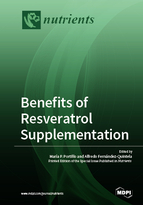Benefits of Resveratrol Supplementation
A special issue of Nutrients (ISSN 2072-6643).
Deadline for manuscript submissions: closed (31 October 2018) | Viewed by 114480
Special Issue Editors
2. CIBER Fisiopatología Obesidad y Nutrición, Instituto de Salud Carlos III, Madrid, Spain
3. BIOARABA Institute of Health, Vitoria-Gasteiz, Spain
Interests: molecular nutrition; nutritional and metabolic diseases; adipocytes; hepatocytes; lipogenesis; fat; inflammatory biomarkers; obesity; non-alcoholic fatty liver disease; insulin signaling; insulin; glucose metabolism; lipid metabolism; insulin resistance; adipogenesis; adipose tissue; liver
Special Issues, Collections and Topics in MDPI journals
Special Issue Information
Dear Colleagues,
In recent years, great attention has been paid to polyphenols due to their positive effects on health. One of the most widely-studied phenolic compounds is resveratrol. This molecule, which is naturally present in some foods, shows beneficial effects on various physiological and biochemical processes, thus representing a potential tool for the prevention or the treatment of diseases highly prevalent in our society. Several of these beneficial effects have been observed in human beings, but others only in pre-clinical studies so far, and therefore, it is mandatory to continue with the scientific research in this field. Indeed, new knowledge concerning these issues could enable the development of novel functional foods or nutraceuticals, incorporating resveratrol, suitable for preventing or treating diseases such as cancer, cardiovascular diseases, obesity, dislipemia, insulin resistance and diabetes, liver diseases, etc.
It is our great pleasure to invite researchers to provide manuscripts either describing original research or providing and up-to-date review of the scientific literature for a Special Issue of Nutrients on "Benefits of Resveratrol Supplementation”. Manuscripts can present recent advances on the knowledge on resveratrol effects on health, including mechanisms of action, dose-response patterns, how to improve bioavailability, combinatorial strategies, population group targets, health claims and with other bioactive molecules.
Prof. María P. PortilloDr. Alfredo Fernandez-Quintela
Guest Editors
Manuscript Submission Information
Manuscripts should be submitted online at www.mdpi.com by registering and logging in to this website. Once you are registered, click here to go to the submission form. Manuscripts can be submitted until the deadline. All submissions that pass pre-check are peer-reviewed. Accepted papers will be published continuously in the journal (as soon as accepted) and will be listed together on the special issue website. Research articles, review articles as well as short communications are invited. For planned papers, a title and short abstract (about 100 words) can be sent to the Editorial Office for announcement on this website.
Submitted manuscripts should not have been published previously, nor be under consideration for publication elsewhere (except conference proceedings papers). All manuscripts are thoroughly refereed through a single-blind peer-review process. A guide for authors and other relevant information for submission of manuscripts is available on the Instructions for Authors page. Nutrients is an international peer-reviewed open access semimonthly journal published by MDPI.
Please visit the Instructions for Authors page before submitting a manuscript. The Article Processing Charge (APC) for publication in this open access journal is 2900 CHF (Swiss Francs). Submitted papers should be well formatted and use good English. Authors may use MDPI's English editing service prior to publication or during author revisions.
Keywords
- Resveratrol supplementation
- Mechanisms of action
- Bioavailability
- Resveratrol metabolites
- Combinatorial strategies
- Benefits on health
- Western society diseases
- Prevention
- Treatment








